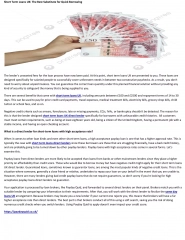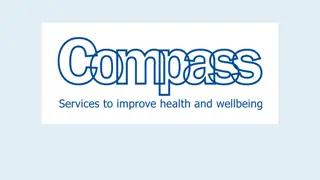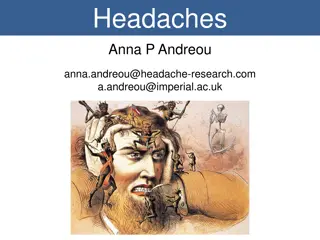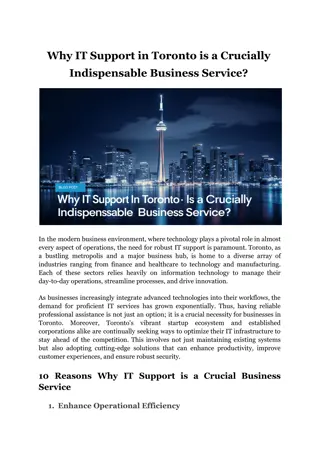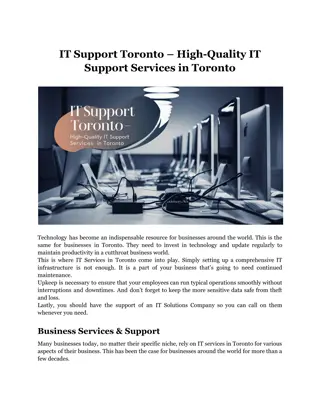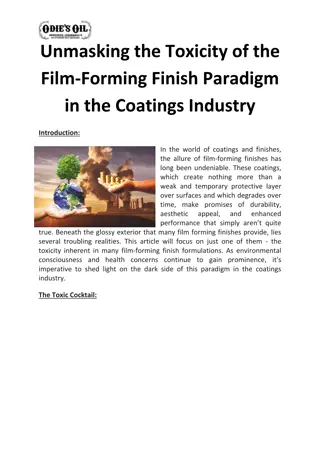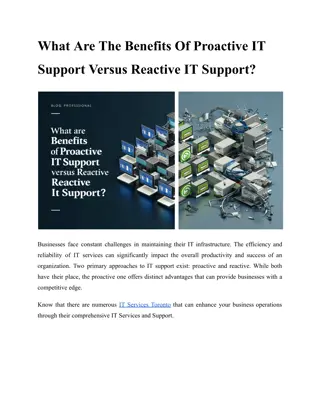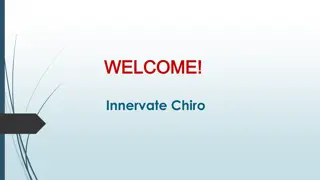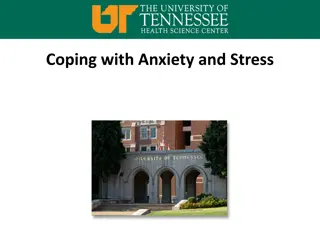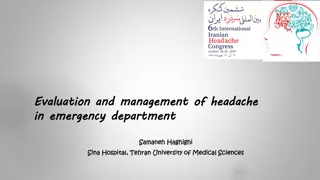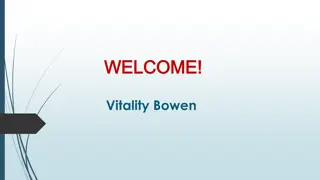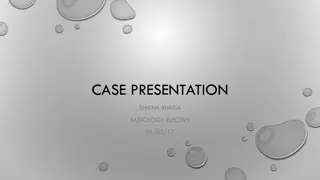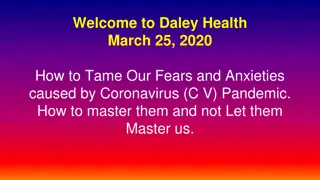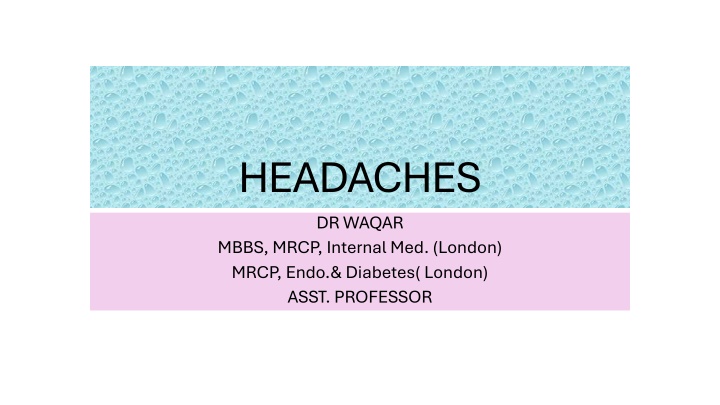
Different Types of Headaches and their Characteristics
Learn about primary and secondary headaches, their classifications, common causes, and specific characteristics such as migraines, tension headaches, and cluster headaches. Discover the signs, symptoms, and possible treatments for each type of headache, including migraines with aura that can be confused with stroke or TIA.
Download Presentation

Please find below an Image/Link to download the presentation.
The content on the website is provided AS IS for your information and personal use only. It may not be sold, licensed, or shared on other websites without obtaining consent from the author. If you encounter any issues during the download, it is possible that the publisher has removed the file from their server.
You are allowed to download the files provided on this website for personal or commercial use, subject to the condition that they are used lawfully. All files are the property of their respective owners.
The content on the website is provided AS IS for your information and personal use only. It may not be sold, licensed, or shared on other websites without obtaining consent from the author.
E N D
Presentation Transcript
HEADACHES DR WAQAR MBBS, MRCP, Internal Med. (London) MRCP, Endo.& Diabetes( London) ASST. PROFESSOR
GENERAL POINTS One of the most common medical issues Multiple etiologies, some very serious and some not. So, diagnosis can be challenging Most cases of chronic headache do not have a serious etiology. Headaches can be due to many systemic diseases, not just problems in the headache
BASIC CLASSIFICATION Primary headaches Secondary headaches Primary headaches Secondary headaches A) Primary headaches: Not secondary to another disease B) Sec. Headaches: secondary to some underlying disease, either intra cranial or extra cranial
SECONDARY HEADACHES 1) Intracranial disease ( meningitis, brain hemorrhage,brain tumor) 2) 2) Eye diseases Eye diseases( vision problems are the commonest) 3) Sinusitis 4) Temporal arteritis ( inflammation of the temporal artery) 5) Head trauma 6) Systemic diseases )HTN)
PRIMARY HEADACHES Some important ones are: Some important ones are: 1) Migraine (& its variants) 2) Cluster Headache 3) Tension Headache (most common type)
MIGRAINE Usually starts in adolescence or early adult life Family history often positive More common in females CHARACTERISTICS: CHARACTERISTICS: 1) Usually unilateral (may be generalized also) 2) Throbbing (may be continuous dull ache also) 3) Each episode lasts for 4-72 hours 4) Pain aggravated with physical activity
5) Often accompanied with nausea, vomiting, photophobia(?), phonophobia (?), visual blurring 6) In some patients, AURA may occur just before the headache AURA AURA: Clinical features which occur 30 to 60 min. before the headache, warning the person that the headache is coming * Visual features Visual features like visual field defects (scotomas), flickering lights, zig zag lines, colored spots before the eyes etc. * Neurological features Neurological features like Numbness, paresthesias, aphasia, weakness, dysarthria
Some points about Aura Occurs only in about 30% Some people get Aura but no headache ( aura without headache). headache). Can be confused with stroke/TIA Aura is not dangerous by itself 30% of the migraine patients aura without
Pathogenesis of Migraine Dysfunction of the neurons in the brain leads to release of chemicals (neuropeptides) act on the intra cranial blood vessels vasoconstriction produces headache Remember 1 important neuropeptide : Calcitonin Gene Peptide Peptide ( a peptide which is related to the calcitonin gene) CGRP Calcitonin Gene- - Related Related CGRP
Things which can trigger a migraine attack Sleep disturbances (less sleep, disturbed sleep pattern) Sleep disturbances (less sleep, disturbed sleep pattern) Emotional & excess physical stress Emotional & excess physical stress Menstruation Menstruation Dehydration Excess exposure to TV / computer screens ( so, no PS4 ) Excess exposure to TV / computer screens ( so, no PS4 ) Foods (C Chocolate, C Cheese, C Coffee, alcohol, MSG found in Chinese foods) Bright & flickering lights Bright & flickering lights Strong smells ( perfumes, benzene, chemicals, food smells) Oral contraceptives
Work up in a Migraine patient Migraine is a clinical diagnosis Migraine is a clinical diagnosis, based on the history There is no blood test or imaging to diagnose Imaging like CT or MRI brain is done to rule out other intracranial pathology diagnose
Management of Migraine 1) Avoid the triggering factors 2) Healthy lifestyle (good sleep, no alcohol, exercise, no stress, avoid TV or mobile phone screens for long periods) 3) Medicines to treat the acute attack 4) Maintenance treatment ( ALAATOOL) in some patients
Management of acute attack 1) Lie down in a dark quiet room 2) Avoid light and loud sounds 3) Medicines ( any of the following). Take at the start of the aura or headache. A A) Simple analgesics (Panadol with caffeine Panadol extra, NSAIDs). Don t overuse ( can lead to medication overuse headache headache ) medication overuse
Management of acute attack (contd.) B B) Ergotamine containing meds.: e.g. Cafergot ( ergotamine + caffeine). Avoid in pregnancy, CAD, HTN. C C) Triptans : eg sumatriptan, zolmitriptan etc. * oral tabs, nasal sprays, subcutaneous injections * Quick relief * They are serotonin receptor agonists serotonin receptor agonists , & prevent the release of migraine causing neuropeptides * Contraindicated in pregnancy, uncontrolled HTN, CAD, history of stroke
D D) Blockers of calcitonin gene related peptides(CGRP inhibitors) E E) Antiemetics: * Metoclopramide, chlorpromazine, prochlorperazine * Used along with analgesics to help the nausea/vomiting Narcotic analgesics are not used (why? )
Chronic management of Migraine Long term treatment given to people who have very frequent acute attacks (more than 3 times a month) 1)Some antihypertension meds like propranolol & candesartan. 2) Anti epileptic meds like Topiramate 3) Antidepressants like Amitryptyline Amitryptyline 4) Some monoclonal antibodies (injections) 5) Acupuncture propranolol, verapamil verapamil, Topiramate, valproic acid
RAPID FIRE QUESTIONS OF MIGRAINE 1) Is it a primary or sec headache? 2) Name some secondary headache syndromes? 3) Name 3 primary headaches? 4) Usual location of migraine? 5) Nature of migraine pain, throbbing or continuous? 6) Other symptoms associated with the attack? 7) What is an aura? 8) Name some visual features of an aura? 9) Name some neurological features of an aura?
10) Is aura LAAZIM in all migraine patients? 11) Aura is dangerous, right or wrong? 12) Aura can occur without any headache, right or wrong? 13)Aura can be confused with what? 14) Which chemicals are released in the brain to cause migraine? Name any 1? 15)Which foods can trigger an attack? 16)Name some more triggering factors?
17) Diagnosis of migraine is based on what, CT or MRI? 18)During acute attack, what should the patient do, besides taking meds? 19)Name the 3 commonly used meds to treat an acute attack? 20)Why not to use pain killers for a long time? 21)Name any triptan? 22)Mode of action of triptans? 23)Name 3 contraindications to use triptans and ergotamine?
24) Name a newer drug to treat the acute attack? 25) What other symptomatic treatment alongwithanalgesics? 26) When to give chronic treatment? 27) Name 3 meds used as chronic management?
Tension Headache 1) Most common type of headache 2) It is due to head and neck muscles becoming tense and tight 3) 3) Clinical features: Clinical features: a. Usually bilateral, in the forehead, neck or generalized b. Like a tight band around the head (not throbbing) c. No nausea/vomiting d. Scalp & forehead tenderness usually MOJOOD e. Patient may have sensitivity to light & sounds ( like migraine) f. No neuro features or aura
Triggering factors are mostly same as migraine ( lack of sleep, dehydration, loud noise, glaring lights, stress etc) ACUTE TREATMENT: ACUTE TREATMENT: a. Take a nap b. Eat something/ take fluids c. Simple analgesics like Panadol, NSAIDs. Muscle relaxants may be added (Relaxon tabs) d. No triptans or other migraine specific drugs e. Apply cold or hot packs to the head
CHRONIC TREATMENT CHRONIC TREATMENT: Given if very frequent headaches. 1. Antidepressants (amitriptyline) 2. Relaxation techniques
Migraine vs. Tension H.A. (comparison) Migraine Migraine Tension H.A. Tension H.A. 1) Usually unilateral 2) Due to vasoconstriction 3) Nausea/Vomiting 4) Neurological features may be present 5) Triggering factors 6) Often have aura 7) Usually throbbing 1) Mostly bilateral/generalized 2) Due to tense muscles 3) No nausea/ vomiting 4) No neurological features 5) Trig. Factors often same 6) No aura 7) Tight band like
Migraine Migraine Tension H.A. Tension H.A. 8) Sensitivity to light & sounds 9) Treatment: simple analgesics, ergotamine, triptans etc. 8) Yes 9) Only simple analgesics. No ergot or triptans
RAPID FIRE QUES OF TENSION H.A. 1) What is the cause of tension headache? 2) What are the triggering factors? 3) What is the treatment? 4) Triptans and ergotamine are very good for this, right or wrong? 5) What is the nature of the headache? 6) Any aura or neuro features? 7) Any associated nausea /vomiting?
CLUSTER HEADACHE CLINICAL FEATURES: CLINICAL FEATURES: 1) Recurrent episodes of severe unilateral eye & temples ( trigeminal distribution) 2) Sudden onset, very very severe headache 3) Accompanied by same side lacrimation, eye redness & swelling, nasal congestion, runny nose & Horner s syndrome (ptosis + meiosis + anhidrosis) meiosis + anhidrosis) unilateral headache, around the ptosis +
4) Each episode lasts for few minutes to hours 5) Attacks occur daily for few weeks, then stop, then recur after a variable period (clusters) 6) No aura 7) Occur at the same time each year (eg spring, winter)
TRIGGERING FACTORS TRIGGERING FACTORS: Many of them same as migraine Etiology: Etiology: Unknown Where is the problem Where is the problem? : Hypothalamus, which somehow affects the trigeminal nerve Diagnosis Diagnosis: Based on symptoms Diff. Diagnosis Diff. Diagnosis: Migraine, Trigeminal neuralgia, Temporal arteritis
TREATMENT A) A) Acute attack: Acute attack: * 100% O2 at high flow rate(15L/min) for about 20 min * Triptans ( intranasal or subcutaneous sumatriptan). Oral tabs not very effective) B) Maintenance Maintenance prophylactic treatment (if attacks are frequent) * Verapamil (first choice) * Lithium tablets
RAPID FIRE QUES OF CLUSTER 1) Location of cluster H.A? 2) Where is the pathology? 3) Clinical features? 4) What is Horner s syndrome? 5) Any triggers? 6) Acute treatment? 7) Chronic treatment? 8) Differential diagnosis? 9) Anu aura?

